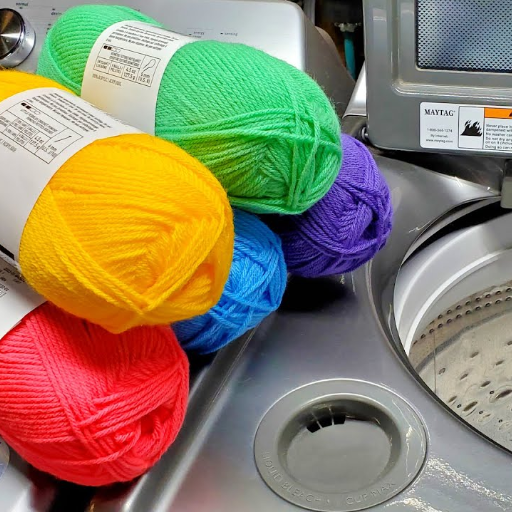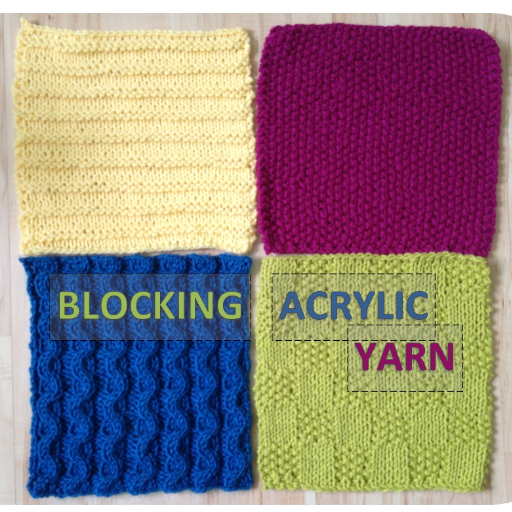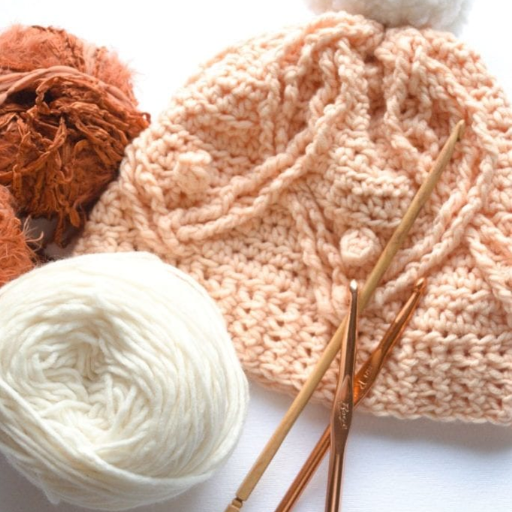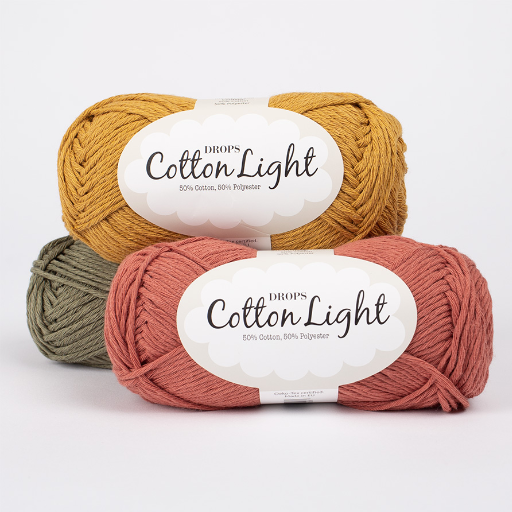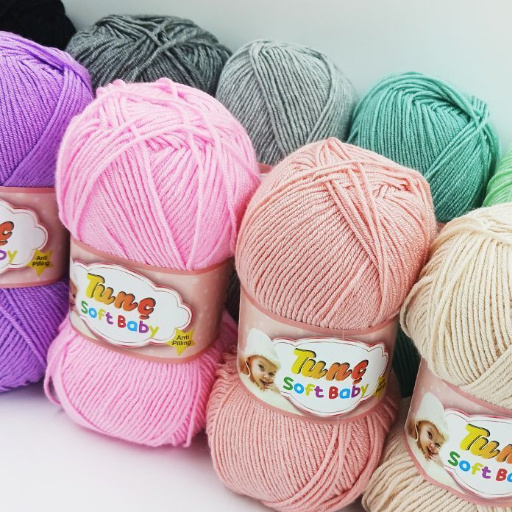There is a wide variety of acrylic yarn available in the market due to its versatility for use in craft projects and its popularity in the textile industry. Acrylic yarn is produced from synthetic wool and it is famous for its low price, high durability, and availability in many different colors. Whether you are an expert knitted or crocheter, or you just dipped your toes in the vast ocean of crafting, knowing the properties and pros and cons of acrylic yarn will definitely in some manner, boost your work.
This blog shall focus on all categories of acrylic yarn such as its production, fundamental features and structure, and primary uses. We shall detail the differences between acrylic yarn and its other fiber counterparts, suggest best practices for crafting with it, and answer the most important and frequent alternative posed question regarding environmental friendliness and care of the yarn. At the end of this blog post, we shall make sure you know everything there is to know about acrylic yarn so you make the best choices for your work.
What is acrylic yarn and How is it Made?

Acrylic yarn is a synthetic fiber made from a polymer known as acrylonitrile, often combined with other chemicals to enhance flexibility, durability, or softness. The production of acrylic yarn begins with the polymerization process, where acrylonitrile monomers are chemically processed to form long chains of molecules. These polymer chains are then dissolved into a solution, which is extruded through spinnerets to create fine fibers. The fibers are solidified, stretched, and crimped to add strength and elasticity before being cut into staple fibers or spun into continuous filaments. This manufacturing process results in a lightweight, versatile yarn that mimics the texture of natural wool while offering water resistance, vibrant color retention, and cost-effective production.
Understanding Acrylic Fibers
Acrylic fibers are synthetic fibers mainly made from acrylonitrile which is a significant compound. Acrylonitrile is a part of the polymer family. In textile manufacturing, it is highly valued due to its wool-like nature, resistance to fading, and durability. Moreover, acrylic is hydrophobic, meaning that it does not absorb water and is quite mildew-resistant. In addition to that, it also checked the lightweight class and consummate absorption of stain. Unlike wool, which is a natural fiber, acrylic fibers are cheaper and make a decent choice for many things such as clothes, furniture, and craft supplies. On the contrary, these fibers tend to be less breathable than natural fibers. Untreated, they are also quite flammable, needing treatment with chemical finishes to reduce that risk.
How is Acrylic Yarn Produced?
The production of acrylic yarn is a multi-stage process to produce synthetic fibers out of polymers in an optimal manner. First, the main ingredient, acrylonitrile, undergoes polymerization, a chemical alteration in which different atoms and molecules combine to form a thermally stable polymer chain. The polymer is then dissolved in a suitable solvent so that it can be processed into fibers. After that the solution is spun, which can be either wet spinning in a coagulating bath, or dry spinning in hot air, forming long continuous filaments.
Afterward, the filaments are spun and pulled or “drawn” to align the molecular structure, increasing strength and elasticity. Crimping and other actions are added to simulate the feel and texture of wool-like natural fibers. The fibers are then chopped into staple lengths, or they can remain as continuous filaments and are prepared for yarn spinning. The last steps include the application of finishing treatments, dyeing, and heat setting for softness, durability, and most importantly, color fastness. This meticulous approach guarantees a broad and economical textile product.
Comparing synthetic and natural yarn
The distinction between synthetic yarn and natural yarn’s composition, method of production, and performance characteristics is profound. Synthetic yarns such as polyester and nylon are sourced from petrochemical industries and are chemically manufactured. These are produced to be consistent, durable, and resistant to moisture and UV rays which makes them perfect for performance and outdoor use. Whereas, natural yarns such as cotton, wool, or silk are cultivated from plants or animals and are cherished for their softness and ease of breathing, along with being biodegradable.
Although synthetic yarns are cast off and easier to produce in bulk, their origin and a slower rate of biodegradability make them less eco-friendly. Natural yarns on the other hand are renewable and are more sustainable, though they need more resources to cultivate which increases their price. Beyond that, natural fibers have the greatest value in comfort and thermal regulation. In contrast, synthetic fibers tend to outperform organic in construction, stain, and color retention odds. Knowing these differences makes it easier to choose the right material for a given use, sustainability objectives, and customer satisfaction.
Why Choose acrylic yarn for Knitting and Crochet?

Acrylic yarn is the best for knitting and crocheting because it is cheap, durable, and very versatile. Besides, it does not mildew or attract pests. Acrylic maintains its form with time which makes it simple to create items that need to endure for a long time. Lastly, acrylic yarn is widely available in different colors and textures which leads to limitless creativity in projects. It is also machine washable and stain resistant which makes it perfect for everyday use. For craft lovers looking for a cheap reliable material, acrylic yarn makes a practical choice.
Benefits of knitting with acrylic yarn
- Affordability: Acrylic yarn is significantly less expensive than many natural fiber alternatives, making it accessible for projects of all sizes, from large blankets to smaller accessories. This affordability allows crafters to experiment and create without financial concerns.
- Durability: Acrylic yarn is known for its strength and resilience. It resists wear and tear over time, making it ideal for items that require frequent handling or washing, such as scarves, hats, and baby blankets.
- Ease of Maintenance: Unlike some natural fibers, acrylic yarn is machine washable and dries quickly. It resists mildew, stains, and pests, making it a low-maintenance option for long-lasting, practical creations.
- Wide Color Range: Acrylic yarn is available in an extensive array of colors and textures, allowing for unmatched creative freedom. With vibrant hues that resist fading, it ensures that finished projects maintain their visual appeal for years.
- Versatility: Acrylic adapts well to a variety of knitting and crochet patterns, making it suitable for beginners as well as advanced crafters. Its elasticity and lightweight nature simplify handling, ensuring a smooth crafting process.
By combining affordability, durability, and versatility, acrylic yarn continues to be a staple for knitting and crochet enthusiasts, offering both beginners and experts a high-performing material for a diverse range of projects.
Common Items Made with Acrylic
Acrylic is a highly versatile material used in a wide range of applications due to its lightweight properties, durability, and aesthetic versatility. Below are some of the most common items made with acrylic:
- Home Decor: Acrylic is frequently used to produce practical and decorative items such as picture frames, organizers, furniture (like chairs and tables), and vases. Its transparency and modern appearance make it an excellent choice for enhancing interior spaces.
- Signage and Displays: Due to its clarity and ease of customization, acrylic is a popular choice for signage, retail displays, and promotional materials. It allows for vibrant colors and precision in cutting and engraving, making it ideal for advertising.
- Aquariums: Acrylic is a preferred material for aquariums because it is stronger and lighter than glass while offering better impact resistance. This makes it safer and easier to handle during manufacturing and installation.
- Outdoor Applications: Many outdoor products, such as windows, skylights, canopies, and protective barriers, are made from acrylic due to their ability to withstand exposure to UV light and various weather conditions without yellowing or degrading.
- Fashion and Accessories: Acrylic is used to craft jewelry, watches, glasses, and even decorative panels for handbags, thanks to its ability to mimic glass or gemstones while being more lightweight and shatter-resistant.
- Crafts and DIY Projects: Acrylic sheets and rods are widely used by crafters for custom projects such as laser-cut designs, wall art, or personalized gifts. The material’s flexibility allows for various shapes and intricate patterns during crafting.
These applications demonstrate the adaptability of acrylic across industries, making it a go-to material for both functional and artistic purposes. Its combination of aesthetic appeal and durability ensures its continued relevance in numerous markets.
Is Acrylic the Right Choice for You?
Acrylic’s selection is based on the requirements of the project or product. It has lightweight structure, great strength, and extreme optical clarity. It’s particulary perfect for applications that require high durability and resistance to impacts as well as weather and UV light. Moreover, it is easy to customize, making it perfect for creative designs and complex structures.
On the other hand, although acrylic is resistant to impacts, it’s still more prone to scratches compared to glass. It would also lack heat resistance which could limit its functionality in certain high temperature environments. In addition, it may require some form of coating to improve its scratches resistance.
In the end, acrylic is the perfect choice for projects that require high design flexibility, outdoor durability, and pristine clarity but adjust maintenance and careful handling in certain applications. Balancing its properties against the specific needs will help you determine its suitability for your use case.
How Does acrylic yarn Compare to Other Yarns?

Acrylic yarn is very affordable, lightweight, easy to care for, and very versatile. Unlike natural materials like wool or cotton, acrylic yarn is a synthetic product. Therefore it is superior to wool and cotton in terms of moisture absorption, mildew growth, and pest infestation. Acrylic yarn also retains color exceptionally well giving it vibrant and long-lasting hues. However, It’s less soft and less breathable than natural fibers; therefore it is not preferred for very sensitive skin. Also, acrylic yarn is less durable due to its susceptibility to pilling and low resistance to heat. Finally, how versatile and cost-effective acrylic yarn is makes it ideal for low-maintenance projects that require bright colors, but considering all factors for specific use cases is recommended.
Acrylic vs. Wool and Cotton
Acrylic yarn is the most attractive option compared to wool and cotton and for good reasons. Wool and cotton can be hard to maintain as well as expensive, while acrylic is easier to take care of, and more affordable, and as a bonus, it does not soak in moisture, mold, or even pests. These reasons make acrylic far easier to deal with compared to natural fibers. Apart from that, wool has its benefits too. It is known for being exceptionally warm along with having a lot of elasticity, which are two major factors that make it great for cold-weather garments. Wool is also strongly breathable and more sturdy compared to acrylic, though it can easily get felted or shrunk which makes caring for it a bit more difficult.
Those who have sensitive skin or want lightweight garments for summer would find cotton to be the best option. That is due to it being hypoallergenic and extremely soft while also allowing for good airflow. But one this to keep in mind is that, just like with wool, cotton does not have the buoyancy of synthetic turn acrylic so spending on cotton may not be the most vibrant idea as it will fade with time. In terms of colors and styles, acrylic is top of the mark. While knitwear with acrylic yarn comes in various stunning colors, its longevity will be compromised due to pilling and a lower tolerance to heat.
When it comes to a project’s particular needs like budget, sturdy, maintenance, and the purpose of the project, that is when you need to pick between acrylic, wool, and cotton. Acrylic yarn is the perfect choice if you are working on an inexpensive and brightly colored project, while wool and cotton are good in terms of durabilty and skin friendliness.
Exploring Alternatives: silk, bamboo, and linen
Silk, bamboo, and linen are excellent alternative materials with unique properties suited for various applications.
Silk, known for its luxurious feel and natural sheen, is a protein fiber obtained from silkworms. It is extremely soft, hypoallergenic, and lightweight while providing excellent insulation properties, making it suitable for use in both warm and cold climates. However, silk is relatively expensive, requires delicate handling, and is less durable than synthetic options.
Bamboo fibers, often promoted as eco-friendly, are derived from the bamboo plant and are lauded for their sustainability. Bamboo fabrics are breathable, moisture-wicking, antibacterial, and incredibly soft, making them ideal for sensitive skin. Additionally, they are durable and biodegradable. However, the manufacturing process of bamboo textiles can vary, and chemical-intensive production methods used in some cases may undermine their eco-friendly reputation.
Linen, made from the fibers of the flax plant, stands out for its notable strength and durability. It is highly breathable and moisture-absorbent, making it perfect for warm climates. Linen is also biodegradable and environmentally friendly due to minimal pesticide requirements during cultivation. That said, it has a tendency to wrinkle easily and requires more maintenance than cotton or synthetic fabrics.
When selecting between silk, bamboo, and linen, consider factors such as cost, environmental impact, durability, and specific project requirements to determine the most suitable option.
The Role of Synthetic Yarns in Modern Crafting
Synthetics are crucial to contemporary crafting because of their adaptability, durability, and cost. They are made from materials such as polyester, nylon, acrylic, and spandex that are designed to have high strength and resistance to wear. Unlike natural fibers, synthetic yarns are more lightweight, quick-drying, and resistant to mold and mildew. Furthermore, the durable texture and vibrant colors aid in offering additional creative possibilities.
The tradeoff is in the environmental cost. Their production relies heavily on petrochemicals and their carbon footprint is incredibly high. Furthermore, the non-biodegradable approach creates unsustainability which leads to long term pollution. To lessen these concerns, many manufacturers are looking towards recycled synthetics as it provides a more eco friendly way of keeping the benefits of synthetic fibers. Overall, the issue remains whether craftsmanship seeking convenience should compromise the environment.
What are the Pros and Cons of knitting with acrylic yarn?

Pros of Knitting with Acrylic Yarn
- Affordability: Acrylic yarn is inexpensive, making it accessible for beginners or large projects.
- Durability: It is resistant to wear and tear, ensuring longer-lasting finished products.
- Ease of Care: Most acrylic yarns are machine washable and quick-drying, requiring minimal maintenance.
- Variety: Available in a wide range of colors and textures, it allows for creative versatility.
- Allergen-Free: Unlike wool, it is suitable for individuals with certain fiber allergies.
Cons of Knitting with Acrylic Yarn
- Environmental Impact: Made from non-biodegradable petrochemicals, it has a significant ecological footprint.
- Texture: It may lack the softness or breathability of natural fibers like wool or cotton.
- Heat Sensitivity: Acrylic can melt or deform when exposed to high heat, making blocking and ironing challenging.
- Pilling: Over time, some acrylic yarns are prone to forming small fiber balls, diminishing their appearance.
- Static Build-Up: It can generate static electricity, which may be inconvenient during use.
Advantages of Using Acrylic Yarn
Acrylic yarn boasts characteristics that help store owners cater to crafters’ requirements while ensuring a profitable venture. To start with, it is very inexpensive, making it accessible for starters and people working on large-scale projects. In addition, its resilience stands out. It is highly durable and boasts consistent resiliency, which ensures protection from any sign of wear and tear in the long run. Furthermore, the acrylic yarn has a wide range of colors that are extremely vivid and those colors do not fade even after several washes. This fabric is lightweight and easy to work with, and being non-allergic makes it ideal for people sensitive to natural fibers like wool. In addition, because it is machine washable and dries fast further adds to its appeal for everyday use. Perhaps one of its greatest advantages is that it can be used to make virtually everything from clothes, and shoes, to challenging home decorations. These benefits alone which focus on modern knitting patterns and crocheting practices solidify its relevancy in the industry.
Potential Drawbacks to Consider
Acrylic yarn is wonderful and versatile, but like most things in the world, it also comes with disadvantages. One of the key problems is the environmental issue. Both sides of the acrylic yarn are manufactured from synthetic polymers, mostly petroleum, which affects its biodegradability. Moreover, it adds to micro-plastic pollution during washing. Also, in comparison to natural fibers, it is not as breathable, which can make hot and humid weather uncomfortable. From a durability perspective, while resistant to most forms of acrylic general wear, it is highly susceptible to pilling, the formation of small balls of fiber on the surface of the acrylic. In addition, for people accustomed to the soft touch of natural fabrics, synthetic fiber can be less pleasant. Lastly, it is more flammable than wool, and thus, special care is needed when handling the yarn. Those factors have to be taken under consideration while determining the appropriateness for definite projects.
How to work with acrylic yarn Effectively
To work with acrylic yarn, one needs to know how to use it and deal with its restrictions. First off, select the correct tools – any metal needles or hooks are suitable as metal provides less friction than natural fibers do which is ideal for acrylic yarn. In terms of addressing pilling, tighter stitch patterns are more suitable as they lessen the surface abrasion and increase the durability of the finished item.
Also, to ensure that there is no unnecessary damage, care instructions need to be followed appropriately. Washing of the acrylic yarn is allowed through a machine, however, it needs to be on gentle cycle with a mesh laundry bag to reduce microplastic release as well as shedding of fibers. While drying, high heat should be avoided as it can cause deformed or stiff yarn, so instead low or no-heat setting should be used.
For projects that need a further level of softness, blending of acrylic with natural fibers is a go-to. “Premium” or “Anti-Pill” softer variants of acrylic are also acceptable. And lastly, making sure adequate tension is set along with the quality of the finish, consistent practice of proper techniques for swatches gauging can be done as it is an affordable material.
How Can You Care for Items Made with acrylic yarn?

To care for items made with acrylic yarn, start by following the manufacturer’s care instructions. Generally, acrylic yarn is machine washable, and using a gentle cycle with cold or lukewarm water is recommended. Employ a mesh laundry bag to protect the fabric and reduce fiber shedding. Always use mild detergents to prevent damage, and avoid fabric softeners as they can coat the fibers and reduce breathability. For drying, use a low-heat or no-heat tumble cycle, or air-dry flat to maintain the item’s shape and softness. Proper storage in a clean, dry place away from direct sunlight will further preserve the integrity of your acrylic yarn projects.
Washing and Maintaining acrylic Garments
To clean acrylic garments effectively, use a gentle washing technique. Acrylic is machine washable but should be cleaned on a delicate cycle with cold or lukewarm water to avoid damage to the fibers. Use a mild detergent specifically designed for synthetic fabrics. Placing the garments in a mesh laundry bag can help minimize stretching and protect delicate knits. It is important to avoid bleach or harsh chemicals, which can weaken the fibers.
After washing, acrylic garments can typically be tumble-dried on a low-heat setting, but air-drying flat is highly recommended to prevent distortion or shrinkage. Avoid wringing the fabric, as it may cause stretching. If ironing is required, use the lowest heat setting and place a clean cloth between the iron and the fabric to prevent melting or damage.
For long-term care, store acrylic items in a cool, dry location, and ensure they are clean before storage to prevent dust accumulation or insect damage. Following these guidelines will keep acrylic garments in optimal condition and extend their lifespan significantly.
Preventing scratchy Textures
To avoid scratchy textures in materials, it is critical to understand the root problem which fundamentally comes from missed surface finishing particularly to clothing, undercuts in processing, or the use of poor quality materials. First of all, all surfaces should be cleaned well and smoothed using power tools or sanders that are appropriate for the material. Also, purchasing raw materials of a higher grade while controlling other manufacturing conditions such as temperature and humidity will lower the chances of surfaces being scratchy. For textiles or fabrics, softening might be improved by pre-washing or conditioning processes. Modifications of this character should be tried systematically to find out the best combination that achieves the purpose.
Best Practices for Blocking and Storage
When implementing blocking and storage solutions, adhering to industry best practices ensures optimal performance, scalability, and reliability. Here are the key principles:
- Data Partitioning and Distribution
Efficient data management begins with partitioning. Divide data into manageable blocks or shards to distribute workloads evenly across storage systems. This approach minimizes bottlenecks and enhances parallel processing capabilities. Utilize consistent hashing algorithms or rule-based schemas to ensure systematic division and retrieval of data.
- Redundancy and Replication
To achieve fault tolerance, implement redundancy by replicating data across multiple storage nodes. This guarantees data availability despite hardware failures. Common practices include leveraging RAID configurations for local redundancy and employing distributed replication in cloud-based storage systems.
- Performance Optimization
Optimize the performance of blocking and storage by using high-speed SSDs for critical data and ensuring sequential data access patterns to reduce latency. Techniques like caching frequently accessed data in memory and implementing write-ahead logs (WAL) for commitment consistency also contribute to improved performance.
- Scalability and Elasticity
Design storage systems with scalability in mind, enabling seamless vertical or horizontal expansion as data grows. Adopt storage solutions that support scalability features, such as dynamically allocating resources in cloud environments or using scalable file systems like HDFS.
- Data Integrity and Security
Protect stored data by employing error-detection mechanisms, such as checksums or hashing, to detect and correct data corruption. Secure storage with robust encryption protocols for data at rest and in transit, coupled with stringent access control measures.
- Regular Maintenance and Monitoring
Monitor storage systems continuously to identify and address performance issues proactively. Implement automated tools to perform diagnostics, anticipate storage needs, and execute routine maintenance, such as defragmentation or rebalancing of data nodes.
By adopting these best practices, organizations can ensure their blocking and storage solutions are efficient, resilient, and aligned with the demands of modern data management.
References
Frequently Asked Questions (FAQ)
Q: What is acrylic yarn made from?
A: Acrylic yarn is a type of synthetic fiber made from acrylonitrile, a man-made fiber. Unlike yarns made from natural fibers like wool or cotton, acrylic yarn is created through a chemical process that produces a durable and versatile material.
Q: How does acrylic yarn compare to natural fibers?
A: Acrylic yarn can be less breathable than natural fibers like wool and cotton, but it offers excellent durability and is often more affordable. It’s a great option for those with wool allergies or for projects that require frequent washing.
Q: Can you mix acrylic yarn with other types of yarn?
A: Yes, acrylic yarn can be mixed with other types of yarn, such as natural fibers like cotton or wool, to create interesting textures and enhance the drape of your knitting project.
Q: What projects are best suited for acrylic yarn?
A: Acrylic yarn is ideal for a wide range of types of projects, from beginner to advanced. It’s great for making blankets, sweaters, and accessories like hats and scarves. Due to its durability, it’s also well-suited for items that will be used frequently and require regular washing.
Q: How do you care for acrylic yarn items?
A: Most acrylic yarn items can be washed in a washing machine, making them easy to care for. However, to maintain the quality, it’s best to use a gentle cycle and avoid high heat when drying.
Q: Can you use acrylic yarn with knitting needles and crochet hooks?
A: Absolutely! Acrylic yarn works well with both knitting needles and crochet hooks, making it a versatile choice for knitters and crocheters alike. It glides smoothly and is easy to work with for all skill levels.
Q: Is acrylic yarn environmentally friendly?
A: Acrylic yarn, being a man-made fiber, does have a higher environmental impact compared to some natural fibers. However, many acrylic yarns are now produced with eco-friendly processes to minimize their environmental footprint.
Q: How does acrylic yarn compare to nylon and other synthetic fibers?
A: Acrylic and nylon are both synthetic fibers, but acrylic is often softer and more wool-like, whereas nylon is known for its strength and elasticity. Acrylic yarn provides warmth and softness similar to natural fibers, making it a popular choice for many knitters.
Q: Can acrylic yarn be used for sock yarn?
A: While acrylic yarn can be used for sock yarn, many knitters prefer blends that include nylon for added durability and elasticity. Acrylic yarn is best suited for projects where warmth and softness are the primary concerns.









